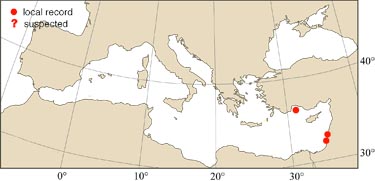
|
Relevant synonyms
Misidentification
Meristic formula
|
|
| photo : Daniel Golani |
|
SHORT
DESCRIPTION
color : typical body coloration of this species is whitish with brown back and a black longitudinal stripe running from the snout to below the end of second dorsal fin base, plus a black spot on the upper caudal peduncle. The specimens collected in the Mediterranean had pinkish background, probably due to their deep depth of collection.
size : common 5-25 cm (max. 30 cm). |
DISTINGUISHING CHARACTERISTICS
BIOLOGY / ECOLOGY
habitat : soft substrate between corals and rocks. |
|
1st
MEDITERRANEAN RECORD
|

|
|
DISTRIBUTION
|
ESTABLISHMENT SUCCESS
speculated reasons for success :
|
|
|
MODE OF
INTRODUCTION |
IMPORTANCE TO
HUMANS |
|
KEY
REFERENCES
|